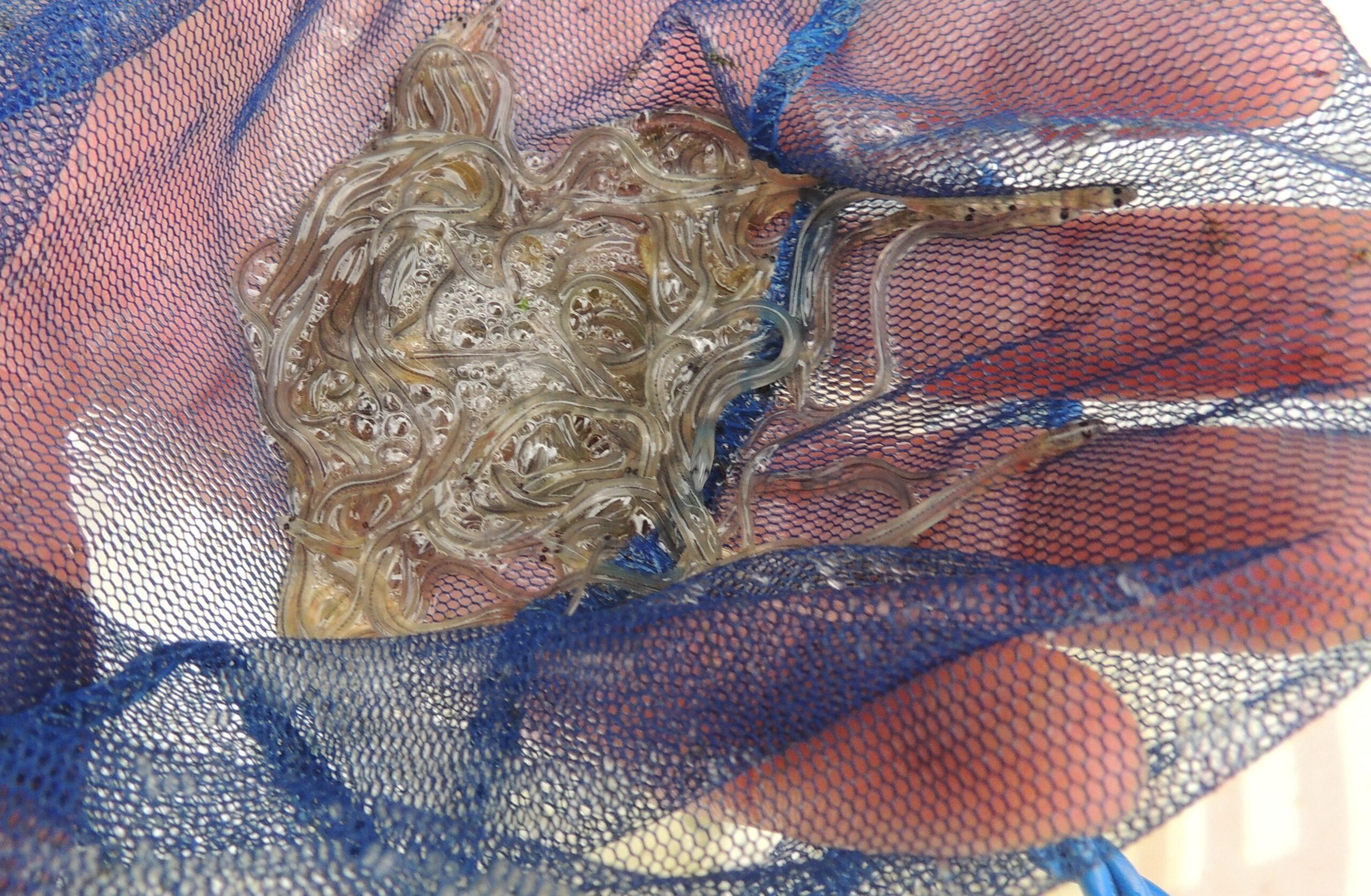Megan Lynch & Kadijah Spence, Master’s Students, Bard Center for Environmental Policy
Background & Life of the American Eel
The American eel, the only freshwater eel found in North America, has a catadromous life cycle, meaning it begins its life in the ocean, migrates to freshwater to mature, and eventually returns to the ocean to spawn. Their large geographic range and unique life cycle make American Eel populations susceptible to a variety threats and makes it difficult to discern the severity of each threat on population numbers. Major threats include barriers to migration from dams, parasites, overfishing, pollution from urbanization, and climate change. Due to their drop in numbers, the International Union for Conservation of Nature (ICUN) added the American Eel to its Red List in 2014.

Eels captured and counted during an eeling session at Bard College. Photo courtesy of Bard College.
The life of every American eel begins in the Atlantic Ocean’s Sargasso Sea. Once hatched, the eel larvae drift towards the Atlantic Coast of the United States with assistance from the Gulf Stream Current. By the time the larvae have reached the coast, they will have transitioned into glass eels, which is the juvenile life stage of the American eel. Upon reaching the coast, the tiny, transparent eels will seek out estuaries that will bring them toward freshwater rivers and streams.
Within a few weeks of entering estuaries, like the Hudson River, the eels will develop into Elvers, the second juvenile stage. Most Elvers will move inland seeking freshwater habitats. To reach these inland habitats, Glass eels and Elvers are able to ascend certain barriers, such as waterfalls, and absorb oxygen through their skin in order to travel briefly over land.
For more information on American Eels and the threats they face, visit the following websites:
US Fish & Wildlife Service: American Eel Overview
IUNC Red List of Threatened Species
SC Department of Natural Resources: American Eel Overview
American Eels in the Saw Kill
It is at this stage that the migrating eels find over 100 tributaries of the Hudson River Estuary, including the Saw Kill. However, once eels enter the Saw Kill, both natural and manmade barriers impede their ability to migrate upstream. The first barrier that the eels approach is the lowest waterfall. Eel density above this first barrier is just 10% of what it is below the waterfall. The installation of an eel ladder on the next barrier, the Lower Saw Kill Dam, facilitates passage, but to a lesser extent than would be possible without a barrier. Further upstream, the area between the Annandale Dam and second lowest waterfall has not been thoroughly sampled. it is expected that eels are present at a very low density.
American Eel populations in North America have drastically declined in recent years, making it important that they are able to access upstream habitats to mature before returning to the Sargasso Sea to spawn. This is possible through the inclusion of eel ladders. The eel ladder at the Lower Saw Kill Dam has passed 1,293 eels since it was operationalized in 2006 through a project with the Department of Conservation Hudson River Estuary Program. The potential addition of an eel ladder on the Annandale could further facilitate upstream passage and support the eel population.
Conservation Efforts
Additional efforts to conserve American eels in the Saw Kill include a monitoring program coordinated with the DEC. Each spring, teams of scientists, students and community members use special nets and traps to collect eels in the Saw Kill, as well as other Hudson River tributaries. The eels are counted, weighed, and released in order to accurate eel population data to decision makers.
Micro hydro intern and BCEP graduate student, Kadijah Spence, had the opportunity to participate in an eeling session in the Saw Kill this past spring. After getting into waders, Kadijah and a group of students gained first hand experience in field methodology while also learning more about the local ecosystem. During the session, 54 eels were caught weighing an average of 0.15 grams per eel.

The eel net which is held down by stakes in the mud. The tail end has sections which are tied off to keep the eels in the net. Photo courtesy of Bard College.

David Scott and Djimon Gibson hold the eel net and looking for eels to place in the bucket. Rose Wax holds the bucket as Katlin Stath counts the number of eels. Photo courtesy of Bard College.

Kadijah Spence during an eeling session in the Saw Kill. Photo Courtesy of Bard College


One response
[…] Barriers- The dam functioning as a barrier for aquatic species is an existing issue. Certain hydropower design options show promise in enhancing fish passage at some level. Because the effectiveness of such designs on enhancing passage is unknown for eels in particular, rigorous monitoring of eel presence downstream and upstream should be conducted in conjunction with more traditional passage enhancements such as ladders and buckets. See more on our discussions related to fish passage on the Saw Kill. […]